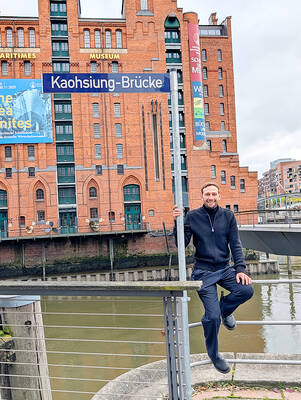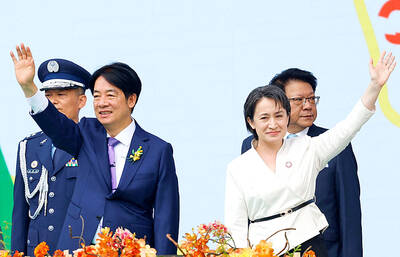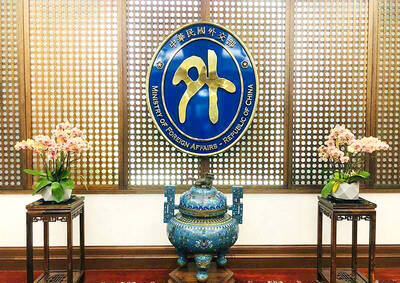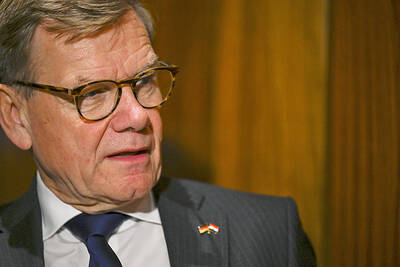After weeks of relatively tame university exchanges, Democratic Progressive Party (DPP) Chairperson and presidential candidate Tsai Ing-wen (蔡英文) yesterday answered cross-strait challenges posed by Chinese students in a lively debate.
Members of a 300-student audience at Shih Hsin University, about two-fifths of them from China on a study-abroad program, asked her respectful but skeptical questions about her party’s opposition to a broader opening to Chinese students.
“I support letting students learn in different places and having access to different experiences and cultures ... but there are practical considerations,” Tsai said when explaining why she favored limited student exchanges with China.
The considerations included a need to focus educational resources on Taiwanese students and keep the job market closed to cross-strait job seekers, she said, sidestepping a question on whether she planned to expand the exchanges if elected next year.
However, Tsai struggled to respond when a Chinese student pointed out to rousing applause that Chinese students were currently barred from entering the job market, unable to receive scholarships and other subsidies, but paid the same tuition fees as Taiwanese students.
On the other hand, the student said, China has opened up its borders to Taiwanese students and created “many beneficial conditions” to entice them to work and study across the strait.
“Other countries use foreign students and the funds they pay to help subsidize their own students,” said the student, who was not identified by name.
She said Tsai “did not seem too enthusiastic” about the issue, despite Tsai’s remarks to the contrary.
In response, Tsai asked what would happen if Taiwan and China’s roles were reversed.
“If Taiwan had the same population as China, or if we had more people and [China] less, would China still widely open up its [borders] to students from Taiwan?” Tsai asked, also to rousing applause.
While Tsai has spoken at universities nationwide as part of her presidential campaign, this is the first time she spoke to an audience almost half-filled with Chinese students, some of whom said they supported her.
One young audience member from China told Tsai that he was a long-time admirer.
“Hopefully my remarks don’t make it back across the Strait, but I’ve been a huge fan ever since I saw Tsai back on Chinese media,” said the student, adding that he saw no reason why Taiwan, “if it wanted to become a ‘normal’ country,” needed to be afraid of China. Instead, it should “open up its heart,” he said.
Despite having only 23 million people, Taiwan should have “enough confidence to deal with China,” the student added.
Tsai responded that: “It’s not fear, it’s only concern.”
“We are concerned that not everyone in China is like you, someone who uses reason and understanding to view Taiwan,” Tsai said. “Then there’s also the concern over the lack of a democratic process in China ... and the problem of the missiles China has aimed at Taiwan.”
Tsai was cautious when asked by a Taiwanese student about her cross-strait policy direction, sticking to her mantra that Taiwan and China needed to maintain a relationship that was “peaceful but different” and was “peaceful and seeking commonality.”
The saying was first used in February when Tsai announced an updated approach on how the DPP would handle relations with China in the future that would stress the two countries’ similarities in responsibilities and interests, but also historical, political and societal differences.
“We must acknowledge that those differences exist. However, we have to co-exist with China ... we must have a peaceful and stable relationship, and this is where our similarities are found,” the presidential candidate said.

The German city of Hamburg on Oct. 14 named a bridge “Kaohsiung-Brucke” after the Taiwanese city of Kaohsiung. The footbridge, formerly known as F566, is to the east of the Speicherstadt, the world’s largest warehouse district, and connects the Dar-es-Salaam-Platz to the Brooktorpromenade near the Port of Hamburg on the Elbe River. Timo Fischer, a Free Democratic Party member of the Hamburg-Mitte District Assembly, in May last year proposed the name change with support from members of the Social Democratic Party and the Christian Democratic Union. Kaohsiung and Hamburg in 1999 inked a sister city agreement, but despite more than a quarter-century of

Taiwanese officials are courting podcasters and influencers aligned with US President Donald Trump as they grow more worried the US leader could undermine Taiwanese interests in talks with China, people familiar with the matter said. Trump has said Taiwan would likely be on the agenda when he is expected to meet Chinese President Xi Jinping (習近平) next week in a bid to resolve persistent trade tensions. China has asked the White House to officially declare it “opposes” Taiwanese independence, Bloomberg reported last month, a concession that would mark a major diplomatic win for Beijing. President William Lai (賴清德) and his top officials

The Ministry of Foreign Affairs (MOFA) yesterday expressed “grave concerns” after Singaporean Prime Minister Lawrence Wong (黃循財) reiterated the city-state’s opposition to “Taiwanese independence” during a meeting with Chinese Premier Li Qiang (李強). In Singapore on Saturday, Wong and Li discussed cross-strait developments, the Singaporean Ministry of Foreign Affairs said in a statement. “Prime Minister Wong reiterated that Singapore has a clear and consistent ‘one China’ policy and is opposed to Taiwan independence,” it said. MOFA responded that it is an objective fact and a common understanding shared by many that the Republic of China (ROC) is an independent, sovereign nation, with world-leading

‘ONE CHINA’: A statement that Berlin decides its own China policy did not seem to sit well with Beijing, which offered only one meeting with the German official German Minister for Foreign Affairs Johann Wadephul’s trip to China has been canceled, a spokesperson for his ministry said yesterday, amid rising tensions between the two nations, including over Taiwan. Wadephul had planned to address Chinese curbs on rare earths during his visit, but his comments about Berlin deciding on the “design” of its “one China” policy ahead of the trip appear to have rankled China. Asked about Wadephul’s comments, Chinese Ministry of Foreign Affairs spokesman Guo Jiakun (郭嘉昆) said the “one China principle” has “no room for any self-definition.” In the interview published on Thursday, Wadephul said he would urge China to